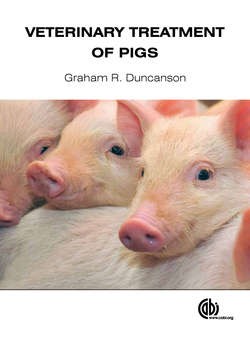Читать книгу Veterinary Treatment of Pigs - Graham R Duncanson - Страница 77
На сайте Литреса книга снята с продажи.
Feeding and notifiable diseases
ОглавлениеFeeding pet pigs is a major problem. First of all there is a potential very serious disease risk from feeding of household scraps. This should be strictly forbidden to avoid the risk of the spread of notifiable diseases, principally foot and mouth disease (FMD) and swine fever (SF). However, this rule is likely to be disobeyed by pet pig owners (Fig. 1.24). Therefore a pet pig might easily be the focus of an outbreak of FMD. It is necessary to clean the feet of pigs being examined to determine whether there are vesicular lesions present; it is important to use only clean water, as detergents and disinfectants will kill the FMD virus and make confirmation difficult. Vesicles are more common on the feet than on the tongue, lips or snout.
Fig. 1.18. Pet pig shelters can be simple.
FMD should always be suspected if vesicular lesions are present, particularly if there is a high mortality in baby pigs. In older pigs morbidity is high but mortality is low.
The most common finding is the sudden onset of severe lameness. There is a high fever up to 41°C. The affected animals will have arched backs and be reluctant to move. If goaded they will squeal pitifully. They will be depressed and anorexic. The incubation period has been recorded as short as 2 days.
It must be remembered that a pig excretes 3000 times more virus particles than a cow, so it is vital that diagnosis is swift. Practitioners in the UK in any doubt should telephone the Department for Environment, Food and Rural Affairs (DEFRA) and stay on the holding until a Veterinary Officer (VO) arrives. If a practitioner is fairly sure that the problem is not FMD, but has just a slight doubt, then there is no harm in telephoning another more experienced colleague in the practice or indeed from a neighbouring practice just to be on the safe side. However if FMD is suspected, obviously both practitioners must stay on the holding until a Government VO has arrived.
Fig. 1.19. Accommodation costs are low for outdoor pigs.
Fig. 1.20. Sharp tin is not acceptable even on a farm on the slopes of Mount Kenya.
Fig. 1.21. This type of tethering is not acceptable.
